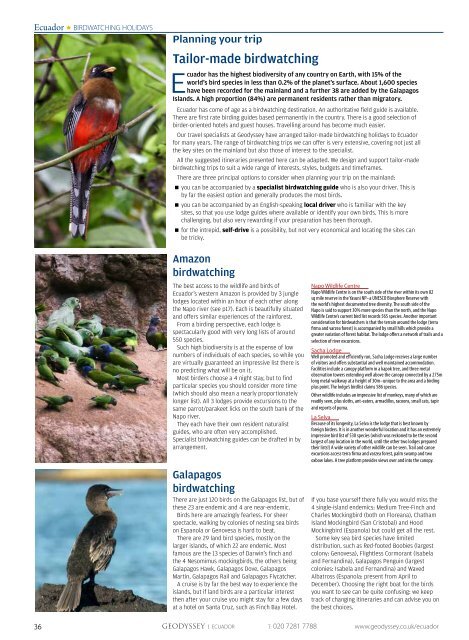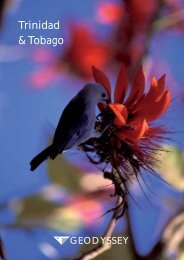Ecuador and the Galapagos Islands - Geodyssey
Ecuador and the Galapagos Islands - Geodyssey
Ecuador and the Galapagos Islands - Geodyssey
Create successful ePaper yourself
Turn your PDF publications into a flip-book with our unique Google optimized e-Paper software.
<strong>Ecuador</strong> ê BIRDWATCHING HOLIDAYS<br />
Planning your trip<br />
Tailor-made birdwatching<br />
<strong>Ecuador</strong> has <strong>the</strong> highest biodiversity of any country on Earth, with 15% of <strong>the</strong><br />
world's bird species in less than 0.2% of <strong>the</strong> planet's surface. About 1,600 species<br />
have been recorded for <strong>the</strong> mainl<strong>and</strong> <strong>and</strong> a fur<strong>the</strong>r 38 are added by <strong>the</strong> <strong>Galapagos</strong><br />
Isl<strong>and</strong>s. A high proportion (84%) are permanent residents ra<strong>the</strong>r than migratory.<br />
<strong>Ecuador</strong> has come of age as a birdwatching destination. An authoritative field guide is available.<br />
There are first rate birding guides based permanently in <strong>the</strong> country. There is a good selection of<br />
birder-oriented hotels <strong>and</strong> guest houses. Travelling around has become much easier.<br />
Our travel specialists at <strong>Geodyssey</strong> have arranged tailor-made birdwatching holidays to <strong>Ecuador</strong><br />
for many years. The range of birdwatching trips we can offer is very extensive, covering not just all<br />
<strong>the</strong> key sites on <strong>the</strong> mainl<strong>and</strong> but also those of interest to <strong>the</strong> specialist.<br />
All <strong>the</strong> suggested itineraries presented here can be adapted. We design <strong>and</strong> support tailor-made<br />
birdwatching trips to suit a wide range of interests, styles, budgets <strong>and</strong> timeframes.<br />
There are three principal options to consider when planning your trip on <strong>the</strong> mainl<strong>and</strong>:<br />
<br />
you can be accompanied by a specialist birdwatching guide who is also your driver. This is<br />
by far <strong>the</strong> easiest option <strong>and</strong> generally produces <strong>the</strong> most birds.<br />
<br />
you can be accompanied by an English-speaking local driver who is familiar with <strong>the</strong> key<br />
sites, so that you use lodge guides where available or identify your own birds. This is more<br />
challenging, but also very rewarding if your preparation has been thorough.<br />
<br />
for <strong>the</strong> intrepid, self-drive is a possibility, but not very economical <strong>and</strong> locating <strong>the</strong> sites can<br />
be tricky.<br />
Amazon<br />
birdwatching<br />
The best access to <strong>the</strong> wildlife <strong>and</strong> birds of<br />
<strong>Ecuador</strong>'s western Amazon is provided by 3 jungle<br />
lodges located within an hour of each o<strong>the</strong>r along<br />
<strong>the</strong> Napo river (see p17). Each is beautifully situated<br />
<strong>and</strong> offers similar experiences of <strong>the</strong> rainforest.<br />
From a birding perspective, each lodge is<br />
spectacularly good with very long lists of around<br />
550 species.<br />
Such high biodiversity is at <strong>the</strong> expense of low<br />
numbers of individuals of each species, so while you<br />
are virtually guaranteed an impressive list <strong>the</strong>re is<br />
no predicting what will be on it.<br />
Most birders choose a 4 night stay, but to find<br />
particular species you should consider more time<br />
(which should also mean a nearly proportionately<br />
longer list). All 3 lodges provide excursions to <strong>the</strong><br />
same parrot/parakeet licks on <strong>the</strong> south bank of <strong>the</strong><br />
Napo river.<br />
They each have <strong>the</strong>ir own resident naturalist<br />
guides, who are often very accomplished.<br />
Specialist birdwatching guides can be drafted in by<br />
arrangement.<br />
<strong>Galapagos</strong><br />
birdwatching<br />
There are just 120 birds on <strong>the</strong> <strong>Galapagos</strong> list, but of<br />
<strong>the</strong>se 23 are endemic <strong>and</strong> 4 are near-endemic.<br />
Birds here are amazingly fearless. For sheer<br />
spectacle, walking by colonies of nesting sea birds<br />
on Espanola or Genovesa is hard to beat.<br />
There are 29 l<strong>and</strong> bird species, mostly on <strong>the</strong><br />
larger isl<strong>and</strong>s, of which 22 are endemic. Most<br />
famous are <strong>the</strong> 13 species of Darwin's finch <strong>and</strong><br />
<strong>the</strong> 4 Nesomimus mockingbirds, <strong>the</strong> o<strong>the</strong>rs being<br />
<strong>Galapagos</strong> Hawk, <strong>Galapagos</strong> Dove, <strong>Galapagos</strong><br />
Martin, <strong>Galapagos</strong> Rail <strong>and</strong> <strong>Galapagos</strong> Flycatcher.<br />
A cruise is by far <strong>the</strong> best way to experience <strong>the</strong><br />
isl<strong>and</strong>s, but if l<strong>and</strong> birds are a particular interest<br />
<strong>the</strong>n after your cruise you might stay for a few days<br />
at a hotel on Santa Cruz, such as Finch Bay Hotel.<br />
Napo Wildlife Centre<br />
Napo Wildlife Centre is on <strong>the</strong> south side of <strong>the</strong> river within its own 82<br />
sq mile reserve in <strong>the</strong> Yasuni NP–a UNESCO Biosphere Reserve with<br />
<strong>the</strong> world’s highest documented tree diversity. The south side of <strong>the</strong><br />
Napo is said to support 30% more species than <strong>the</strong> north, <strong>and</strong> <strong>the</strong> Napo<br />
Wildlife Centre’s current bird list records 565 species. Ano<strong>the</strong>r important<br />
consideration for birdwatchers is that <strong>the</strong> terrain around <strong>the</strong> lodge (terra<br />
firma <strong>and</strong> varzea forest) is accompanied by small hills which provide a<br />
greater variation of forest habitat. The lodge offers a network of trails <strong>and</strong> a<br />
selection of river excursions.<br />
Sacha Lodge<br />
Well promoted <strong>and</strong> efficiently run, Sacha Lodge receives a large number<br />
of visitors <strong>and</strong> offers substantial <strong>and</strong> well maintained accommodation.<br />
Facilities include a canopy platform in a kapok tree, <strong>and</strong> three metal<br />
observation towers extending well above <strong>the</strong> canopy connected by a 275m<br />
long metal walkway at a height of 30m–unique to <strong>the</strong> area <strong>and</strong> a birding<br />
plus point. The lodge’s birdlist claims 586 species.<br />
O<strong>the</strong>r wildlife includes an impressive list of monkeys, many of which are<br />
readily seen, plus sloths, ant-eaters, armadillos, racoons, small cats, tapir<br />
<strong>and</strong> reports of puma.<br />
La Selva<br />
Because of its longevity, La Selva is <strong>the</strong> lodge that is best known by<br />
foreign birders. It is in ano<strong>the</strong>r wonderful location <strong>and</strong> it has an extremely<br />
impressive bird list of 530 species (which was reckoned to be <strong>the</strong> second<br />
largest of any location in <strong>the</strong> world, until <strong>the</strong> o<strong>the</strong>r two lodges prepared<br />
<strong>the</strong>ir lists!) A wide variety of o<strong>the</strong>r wildlife can be seen. Trail <strong>and</strong> canoe<br />
excursions access terra firma <strong>and</strong> varzea forest, palm swamp <strong>and</strong> two<br />
oxbow lakes. A tree platform provides views over <strong>and</strong> into <strong>the</strong> canopy.<br />
If you base yourself <strong>the</strong>re fully you would miss <strong>the</strong><br />
4 single-isl<strong>and</strong> endemics: Medium Tree-Finch <strong>and</strong><br />
Charles Mockingbird (both on Floreana), Chatham<br />
Isl<strong>and</strong> Mockingbird (San Cristobal) <strong>and</strong> Hood<br />
Mockingbird (Espanola) but could get all <strong>the</strong> rest.<br />
Some key sea bird species have limited<br />
distribution, such as Red-footed Boobies (largest<br />
colony: Genovesa), Flightless Cormorant (Isabela<br />
<strong>and</strong> Fern<strong>and</strong>ina), <strong>Galapagos</strong> Penguin (largest<br />
colonies: Isabela <strong>and</strong> Fern<strong>and</strong>ina) <strong>and</strong> Waved<br />
Albatross (Espanola: present from April to<br />
December). Choosing <strong>the</strong> right boat for <strong>the</strong> birds<br />
you want to see can be quite confusing: we keep<br />
track of changing itineraries <strong>and</strong> can advise you on<br />
<strong>the</strong> best choices.<br />
36 GEODYSSEY | ECUADOR T: 020 7281 7788 www.geodyssey.co.uk/ecuador



